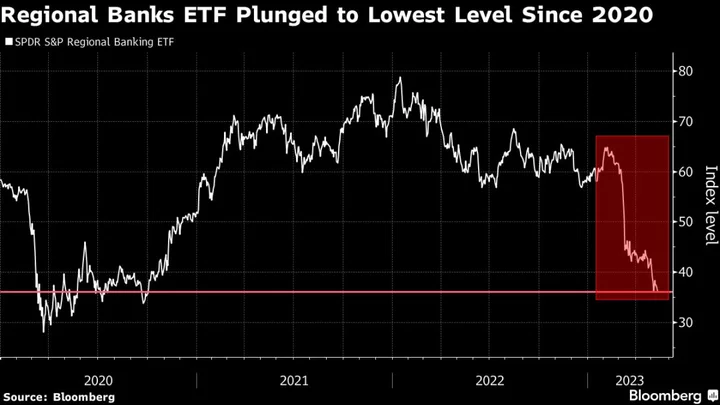The fear-driven selloff that’s cut the stock-market values of some banks in half may look like a perfect chance to buy the dips. If only they’d stop falling.
As shares of lenders tumbled for a fourth straight week, investors are showing signs of throwing in the towel. They yanked $2.1 billion out of financial stocks in the week through May 10, the most since May 2022, according to Bank of America Corp. strategists citing EPFR Global data. Exchange-traded funds focused on the sector saw the biggest exodus of cash since September, according to Refinitiv Lipper. And the $29 billion Financial Select Sector SPDR Fund has seen more than $2 billion pulled out over just the past two weeks.
The retreat threatens to prolong the rout sparked by the collapse of Silicon Valley Bank and other lenders over the past two months. Those failures fueled widespread concerns that others would be hammered by a similar combination of rising costs and mounting losses as the Federal Reserve’s most aggressive interest-rate hikes in a decade ripple through the economy.
The selloff has emboldened short sellers and turned regional banks into one of the hardest hit corners of the stock market this year, with Western Alliance Bancorp, Zions Bancorp, Comerica and KeyCorp all tumbling by at least 50% since the start of March. Eight of the 10 worst performers in the S&P 500 this year are financials.
Hovde Group analyst Ben Gerlinger has been insistent that the drop in Western Alliance’s stock is unjustified and irrational, saying the bank is in a stronger position than its peers. But he said trading has taken on a herd mentality, with investors turning on bank stocks altogether.
“There’s not a lot of confidence that the bank runs will stop,” said Gerlinger, though he said data shows deposit outflows overall for regional banks were muted and much of the fear is misplaced. The analyst has an “outperform” rating on Western Alliance and expects the stock price to roughly double over the next year.
Regulators have also tried to instill confidence in the nation’s banks, with Fed Chair Jerome Powell insisting that the system is “sound and resilient” after First Republic was seized and sold off to JPMorgan Chase & Co.
But that has done little to calm investors concerned about an array of forces that are squeezing banks. Among them: pressure to push up deposit rates to staunch the outflow of cash to higher-yielding money-market funds; mark-to-market losses on assets; and the risk of defaults on small business and commercial real estate loans if the economy contracts and high office vacancies persist.
“History would suggest that you don’t see and smell this much smoke, and then have everything be just fine,” said Ann Miletti, head of active equity at Allspring Global Investments.
When the turmoil first broke out in early March, there were some signs that investors were trying to make quick profits by buying the dips — a tactic that proved profitable during the pandemic’s bull market. The Financial Select Sector SPDR Fund, for example, pulled in some $1.2 billion during one week in mid-March.
The latest efforts turned out to be ill-timed, however, as bank stocks failed to bounce back, leaving investors hesitant to try again. Take the SPDR S&P Regional Banking ETF: since March, it has seen daily declines of at least 5% six times. Yet, according to an analysis by Bespoke Investment Group, in the weeks afterward, it posted a median decline of 2%. Meanwhile, the KBW Bank Index, which tracks 21 lenders, has tumbled more than 33% since early March.
“While investors have been buying dips in the broader market this year, they haven’t been as eager to do so for regional banks,” said Paul Hickey, a co-founder of Bespoke.
The drubbing has cheapened the valuations of regional bank stocks significantly. The stocks in the KBW benchmark are trading at about 7 times their earnings, according to data compiled by Bloomberg. That’s less than half what it was at the end of 2020 and compares with a price-to-earnings ratio of nearly 19 for the S&P 500. Even so, some investors aren’t convinced they don’t have further to fall.
“There is structural weakness in the model of the regional banks that they can’t rely on their deposit base and therefore how can they make loans that are attractive and create the net interest margin that they need?” said David Neuhauser, founder and chief investment officer of hedge fund Livermore Partners. “That’s a function of the business model and the environment and both are extremely uncertain.”
“Right now, it is extremely difficult to say with any level of certainty that this sector is one to buy,” he said.
--With assistance from Bailey Lipschultz and Elena Popina.
Author: Alexandra Semenova, Bre Bradham and Jessica Menton

